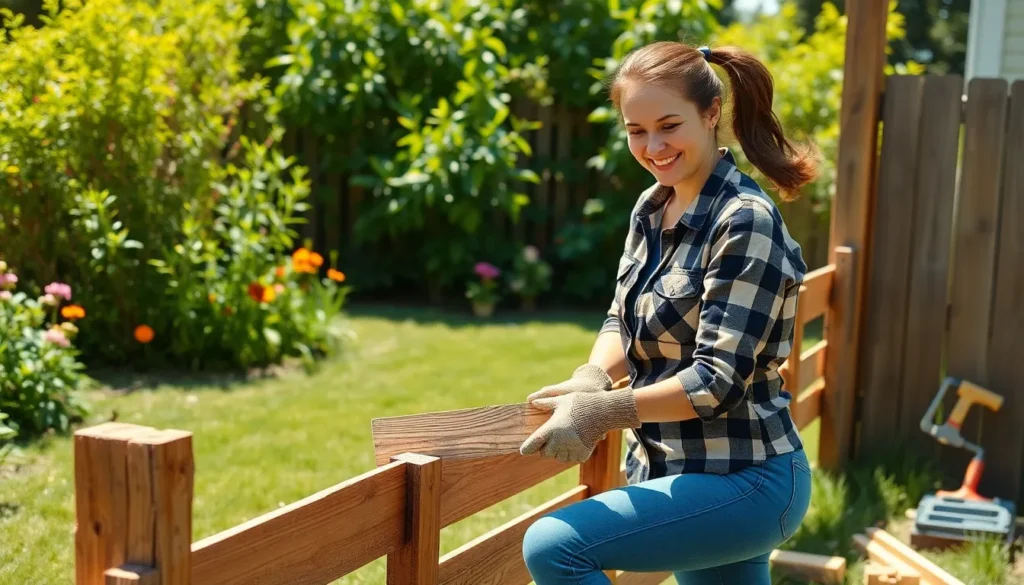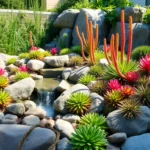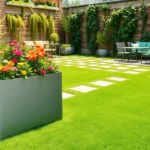We’ve all stood in our backyards dreaming of the perfect fence that’ll transform our outdoor space without very costly. DIY garden fencing isn’t just about saving money – it’s about creating something uniquely yours that reflects your style and meets your exact needs.
Whether you’re looking to add privacy, keep pets contained, or simply define your garden boundaries, building your own fence opens up endless possibilities. From rustic wooden pickets to modern metal panels, the options are limited only by your imagination and skill level.
DIY garden fences offer incredible flexibility in design, materials, and budget. You’ll discover that with the right tools, materials, and a weekend of dedication, you can create a stunning boundary that’ll be the envy of your neighborhood while adding important value to your property.
Rustic Wooden Fence Ideas for Natural Garden Appeal
Wooden fences create timeless appeal while blending seamlessly with natural garden landscapes. These rustic designs offer exceptional versatility for DIY enthusiasts seeking authentic outdoor charm.
Reclaimed Wood Panel Fencing
Reclaimed wood panel fencing transforms salvaged materials into stunning garden barriers that showcase unique character and weathered beauty. We recommend sourcing materials from old barns, demolished buildings, or lumber yards specializing in reclaimed wood to achieve authentic rustic appeal.
Installing these panels requires minimal preparation since the wood’s natural aging process eliminates the need for artificial weathering treatments. Each panel tells its own story through distinctive grain patterns, nail holes, and color variations that new lumber simply cannot replicate.
Construction involves these key steps:
- Measuring panel sections to fit your property boundaries
- Setting sturdy posts every 6-8 feet using concrete footings
- Attaching horizontal support rails between posts
- Securing reclaimed boards vertically or horizontally based on your preferred style
Material costs typically range from $8-15 per linear foot depending on wood type and availability in your area. Popular reclaimed options include weathered pine, oak, and chestnut that develop beautiful silver gray patinas over time.
Split Rail Fence with Wire Mesh
Split rail fence with wire mesh combines rustic wooden aesthetics with practical functionality for containing pets and defining garden spaces. We often recommend this style for homeowners seeking a traditional farm look without sacrificing security.
Building this fence type starts with installing pressure treated posts at 8-foot intervals to support the horizontal rails. The classic three rail design provides optimal stability while maintaining an open, welcoming appearance that doesn’t block garden views.
Essential materials include:
- Split rails (cedar or pressure treated pine)
- Corner and line posts
- Galvanized wire mesh (4-foot height works best)
- Fence staples and hardware
Wire mesh attachment transforms a decorative boundary into a functional barrier that prevents small animals from entering garden beds. Stretching the mesh tightly between posts ensures long lasting performance while maintaining the fence’s rustic charm.
Total project costs typically range from $12-18 per linear foot including materials and basic hardware. Cedar rails cost more initially but offer superior weather resistance and natural insect repelling properties.
Cedar Picket Fence with Decorative Tops
Cedar picket fence with decorative tops creates classic cottage garden appeal while providing privacy and security for outdoor spaces. We particularly appreciate cedar’s natural resistance to rot, insects, and weather damage that makes it ideal for long term garden installations.
Crafting decorative picket tops allows for creative expression through various cutting patterns including pointed, rounded, scalloped, or Gothic arch designs. Each style creates different visual effects that complement exact garden themes and architectural features.
Popular decorative top options:
- Pointed tops for traditional cottage gardens
- Rounded caps for softer, more welcoming appearances
- Scalloped edges for Victorian inspired designs
- Gothic arches for formal garden settings
Installation begins with setting posts every 6-8 feet followed by attaching horizontal rails at top and bottom positions. Individual pickets mount to these rails with consistent spacing (typically 1/2 inch gaps) to create uniform appearance while allowing air circulation.
Material expenses generally run $15-25 per linear foot for premium cedar pickets with custom decorative tops. The investment pays dividends through decades of low maintenance performance and timeless aesthetic appeal that enhances property values.
Modern Metal Fence Designs for Contemporary Gardens
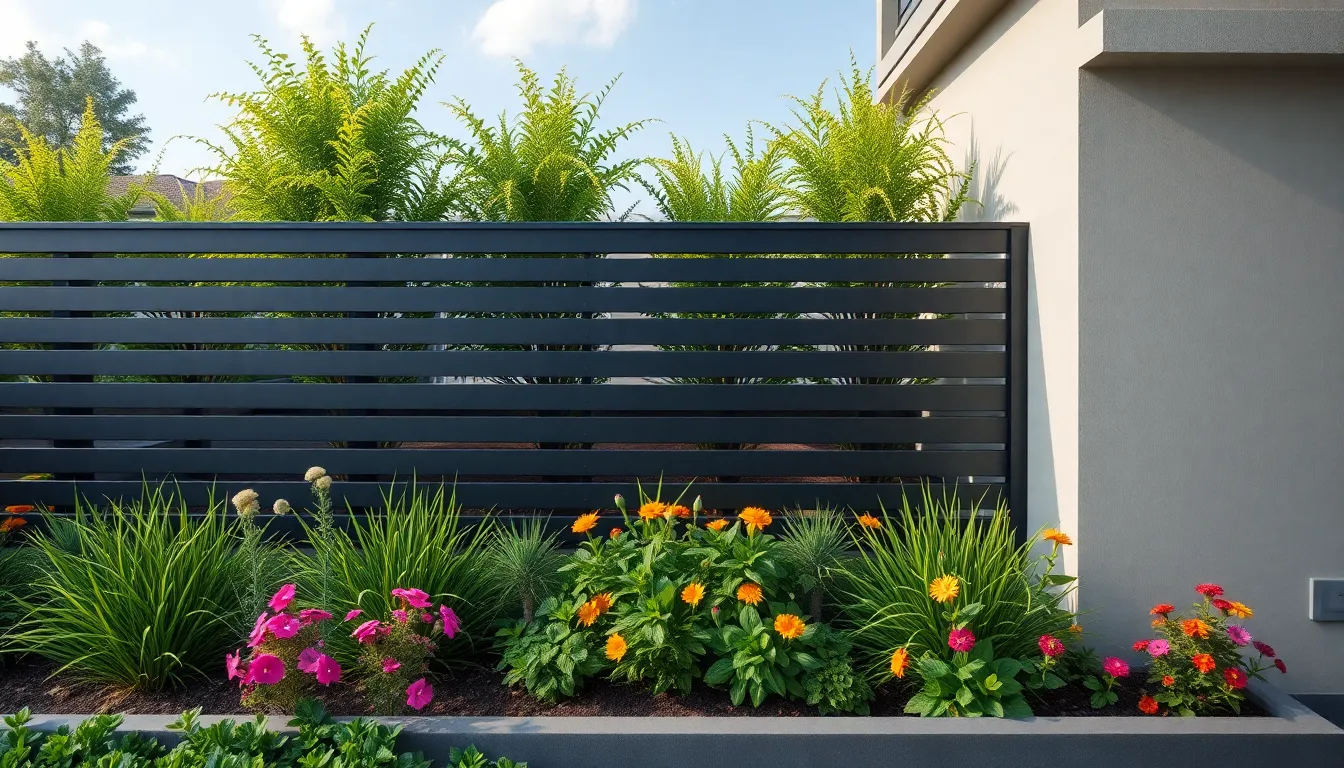
Moving from rustic wooden options to contemporary aesthetics, we’ll explore sleek metal fencing answers that complement modern garden designs.
Horizontal Steel Slat Fencing
Horizontal steel slat fencing transforms contemporary gardens with its streamlined appearance and geometric precision. We love how these horizontal steel slats create clean lines that complement minimalist landscapes and modern architecture. Installing this design requires mounting steel slats horizontally between sturdy posts, typically spaced 6-8 feet apart for optimal stability.
Cost considerations make this option attractive for budget-conscious homeowners. Material expenses generally range from $20-35 per linear foot, depending on steel thickness and finish quality. Standard installation involves setting metal posts in concrete, then securing pre-cut slats with brackets or welding for permanent attachment.
Maintenance requirements stay minimal with proper steel treatment. We recommend choosing powder-coated or galvanized steel slats to prevent rust and extend lifespan. Regular cleaning with soap and water keeps the fence looking pristine for years.
Wire Grid Panel Installation
Wire grid panels offer versatility and modern appeal for contemporary garden boundaries. These minimalist structures provide security while maintaining visual openness, making small gardens appear larger. We find that welded wire mesh panels work best for this application, offering durability and clean aesthetics.
Installation simplicity makes this an ideal weekend DIY project. Setting metal posts at 6-foot intervals creates the foundation, then we attach pre-fabricated grid panels using clips or brackets. Material costs typically run $12-20 per linear foot, making this one of the more affordable modern options.
Design flexibility allows customization for exact garden needs. We can vary panel heights from 3-6 feet depending on privacy requirements. Adding climbing plants like jasmine or clematis softens the industrial look while maintaining the modern framework.
Corrugated Metal Sheet Barriers
Corrugated metal sheets deliver industrial elegance perfect for contemporary garden design. This durable material withstands harsh weather conditions while providing complete privacy screening. We appreciate how the vertical ridges add visual texture and architectural interest to flat garden spaces.
Installation techniques require basic carpentry skills and standard tools. Mounting corrugated sheets between wooden or metal posts creates a striking barrier that costs approximately $15-25 per linear foot. We recommend using galvanized or weather-resistant coated sheets to prevent corrosion.
Customization options expand creative possibilities for unique garden aesthetics. Painting sheets in bold colors creates dramatic focal points, while natural weathering develops an attractive patina over time. Adding horizontal accent strips or varying sheet heights creates ever-changing visual rhythm along the fence line.
Creative Recycled Material Fence Solutions
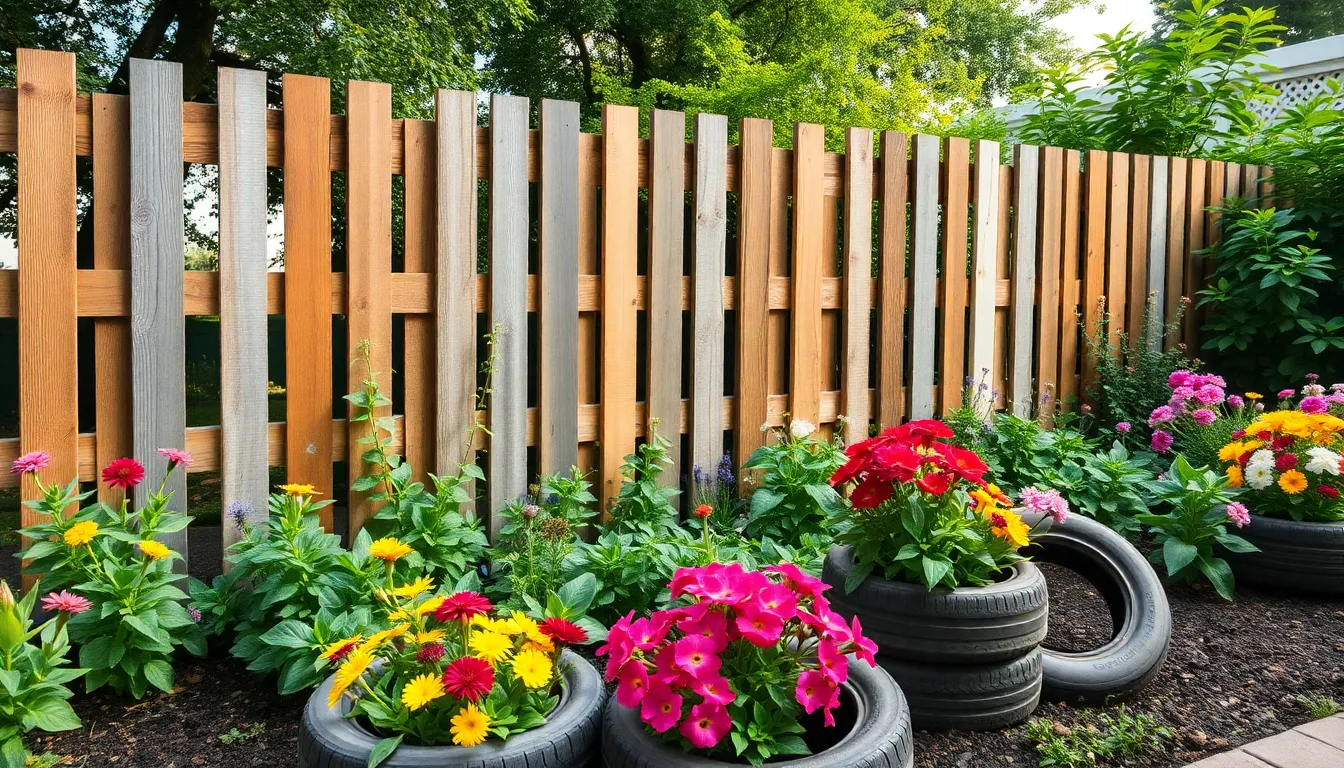
Transforming discarded materials into functional garden fences reduces waste while creating unique boundaries that reflect our personal style. We’ll explore innovative ways to repurpose everyday items into stunning fence answers that won’t break the budget.
Pallet Wood Fence Construction
Pallets offer an exceptional starting point for DIY fence projects, providing readily available materials that can be deconstructed into individual fence slats. We can source these wooden platforms from local businesses, shipping companies, or online marketplaces at minimal cost.
Design flexibility makes pallet wood fences particularly appealing for creative homeowners. Vertical installations create a classic picket fence appearance, while horizontal configurations deliver a modern, streamlined look. Mixed patterns combine both orientations to produce ever-changing visual interest throughout our garden perimeter.
Construction steps begin with dismantling pallets carefully to preserve the wood quality. We’ll need to remove nails, sand rough surfaces, and treat the lumber with weather-resistant stain or sealant. Standard pallet boards typically measure 3.5 inches wide, making them perfect for fence slat spacing.
Old Door and Window Frame Fencing
Repurposing old doors creates sturdy fence panels that provide excellent security and visual appeal for our garden boundaries. Solid wood doors work exceptionally well, offering durability that withstands weather conditions while maintaining their decorative charm.
Installation process involves mounting doors between fence posts using heavy-duty hinges or direct attachment brackets. We can preserve the original door hardware like handles and locks to enhance the vintage aesthetic. Multiple doors create a continuous fence line with varied heights and styles.
Window frames add decorative elements when integrated into fence structures, either as standalone panels or combined with other materials. We can hang individual frames at different heights to create artistic garden displays. Grouping multiple window frames together forms larger fence sections with interesting geometric patterns.
Tire Planter Fence Combination
Using old tires as planters while creating fence boundaries produces a unique garden feature that serves dual purposes. We can stack tires vertically to form walls or arrange them horizontally along property lines to define garden spaces.
Integration techniques combine tire planters with other recycled materials like pallets or metal sheets to create diverse, eco-friendly garden fences. Painting tires in coordinating colors enhances their appearance and ties them into our overall garden design scheme.
Planting options transform utilitarian tires into vibrant garden elements filled with flowers, herbs, or vegetables. We can drill drainage holes in tire bottoms and add quality soil to support healthy plant growth. This combination approach maximizes garden space while establishing clear boundaries around our outdoor areas.
Living Fence Ideas Using Plants and Natural Materials
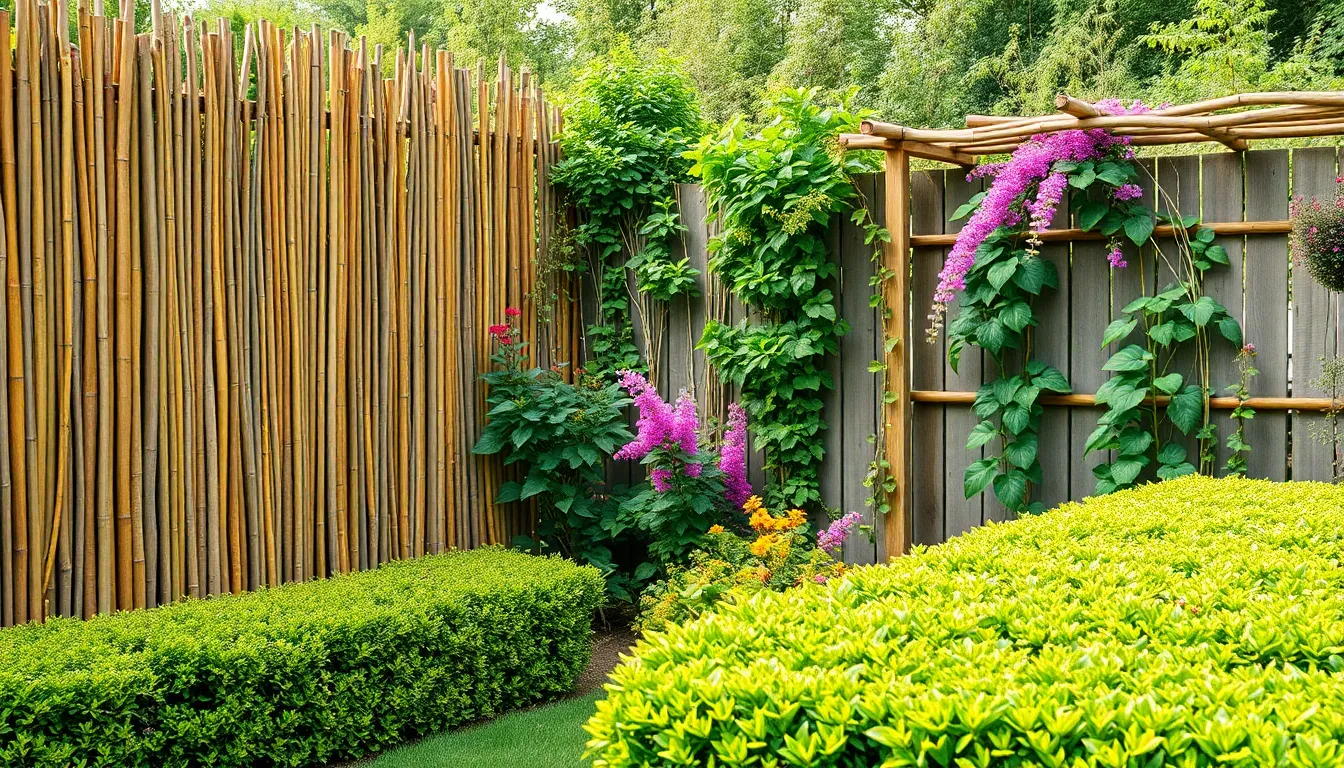
Creating living fences transforms your garden into a vibrant network while providing privacy and boundaries. These natural answers combine functionality with environmental benefits.
Bamboo Screen Fence Installation
Bamboo panels offer an eco-friendly alternative that delivers immediate privacy and lasting durability. We recommend using natural or treated bamboo panels attached to wooden posts for optimal stability and weather resistance.
Natural bamboo costs typically range from $8-20 per linear foot depending on height and thickness. Treatment with protective sealants extends lifespan to 10-15 years even in harsh weather conditions.
Installation involves setting 4×4 wooden posts every 6-8 feet using concrete anchors. Secure panels with galvanized screws or brackets designed specifically for bamboo materials. Create custom bamboo screens by weaving individual bamboo sticks together around vertical support stakes.
Maintenance requires annual cleaning with mild soap answers and periodic reapplication of protective treatments. Bamboo naturally resists insects and provides excellent sound dampening properties.
Willow Branch Weaving Technique
Flexible willow branches create stunning woven fences that combine artistry with functionality. We’ve found this traditional technique produces barriers that strengthen over time as the living willow takes root.
Harvest willow branches during dormant winter months when sap flow is minimal. Select branches 6-10 feet long with consistent diameter for uniform weaving patterns. Fresh cut branches remain pliable for 2-3 weeks when stored properly.
Begin installation by driving vertical stakes 18-24 inches into ground at 12-inch intervals. Weave horizontal willow branches around stakes using alternating over-under patterns. Compress each row tightly against the previous layer to eliminate gaps.
Living willow fencing costs approximately $5-12 per linear foot depending on branch availability and labor requirements. Properly installed willow fences last 15-20 years with minimal maintenance beyond occasional trimming of new growth.
Hedge and Trellis Combination Fencing
Combining hedge plantings with trellis systems creates multi-layered privacy barriers that evolve throughout seasons. We recommend this approach for maximum visual interest and functional versatility.
Plant hedge varieties like boxwood, yew, or juniper 18-24 inches apart along your fence line. Install wooden or metal trellises behind hedges to support climbing plants like clematis, ivy, or honeysuckle. This combination provides immediate structure while hedges mature.
| Plant Type | Spacing | Mature Height | Growth Rate |
|---|---|---|---|
| Boxwood | 18-24 inches | 4-6 feet | Slow (6 inches/year) |
| Yew | 24-36 inches | 6-10 feet | Medium (12 inches/year) |
| Juniper | 36-48 inches | 8-15 feet | Fast (18 inches/year) |
Trellis materials range from $15-40 per linear foot depending on design complexity and material quality. Wooden trellises require treatment every 2-3 years while metal options need minimal maintenance.
Train climbing vines using soft ties during their first growing season to establish proper growth patterns. Prune hedges annually during dormant seasons to maintain desired shape and density. This combination approach creates living architecture that provides year-round privacy and seasonal color changes.
Decorative Painted Fence Designs for Colorful Gardens
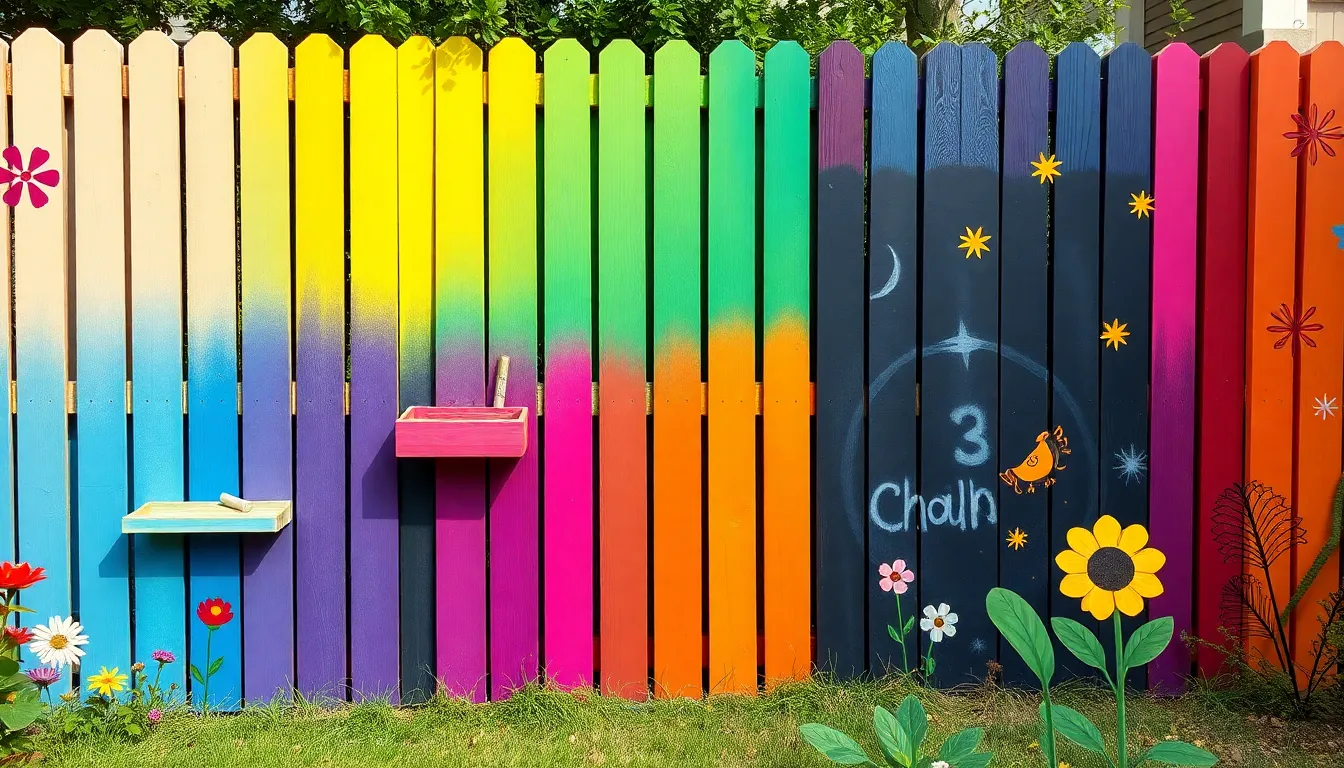
Transform your ordinary fence into a vibrant garden feature with creative paint techniques that add personality and charm to your outdoor space. Painted fences offer an affordable way to inject color and visual interest while complementing your garden’s overall aesthetic.
Chalkboard Paint Fence for Kids’ Areas
Creating an interactive play zone becomes effortless when we apply chalkboard paint to fence sections designated for children’s activities. This clever technique transforms any wooden or metal fence panel into a giant drawing surface where kids can express their creativity outdoors.
We recommend using high-quality exterior chalkboard paint that withstands weather conditions and provides a smooth writing surface. Start by cleaning the fence thoroughly and applying a primer if working with raw wood or previously painted surfaces. Apply two thin coats of chalkboard paint using a foam roller for the smoothest finish.
Position these chalkboard sections at child-friendly heights, typically 2-4 feet from ground level. Consider creating multiple panels along different fence sections to accommodate various age groups and activities. Add a small shelf or ledge below each panel to hold chalk and erasers, keeping supplies organized and easily accessible.
Ombre Color Gradient Techniques
Achieving stunning ombre effects requires gradual color transitions that create visual depth and modern appeal along your fence line. We suggest starting with two to three complementary colors that blend naturally into each other for the most professional looking results.
Begin by selecting your lightest and darkest shades, then create intermediate tones by mixing these base colors together. Work in small sections while the paint remains wet, blending colors using a large brush or foam applicator with smooth, overlapping strokes.
Vertical ombre applications work particularly well on tall fences, transitioning from light colors at the top to darker shades near the ground. Horizontal gradients create width illusions in narrow garden spaces and complement low shrub plantings beautifully. Practice your blending technique on a sample board first to perfect your color transitions.
Stenciled Pattern and Motif Applications
Stenciled designs allow us to add intricate patterns and meaningful motifs without requiring advanced artistic skills. Popular choices include geometric shapes, floral patterns, nature scenes, and inspirational quotes that reflect your garden’s personality.
Purchase pre-made stencils from create stores or create custom designs using cardboard or plastic sheeting. Secure stencils firmly against the fence using painter’s tape to prevent paint bleeding underneath. Apply paint using a stencil brush or foam dauber with light tapping motions rather than brushing strokes.
Layer multiple stencil patterns for complex designs, allowing each layer to dry completely before applying the next. Consider using metallic paints for accents or creating shadow effects by slightly offsetting duplicate patterns. Space your motifs evenly across fence sections, measuring distances carefully to maintain professional alignment throughout your garden perimeter.
Budget-Friendly Wire and Mesh Fence Options
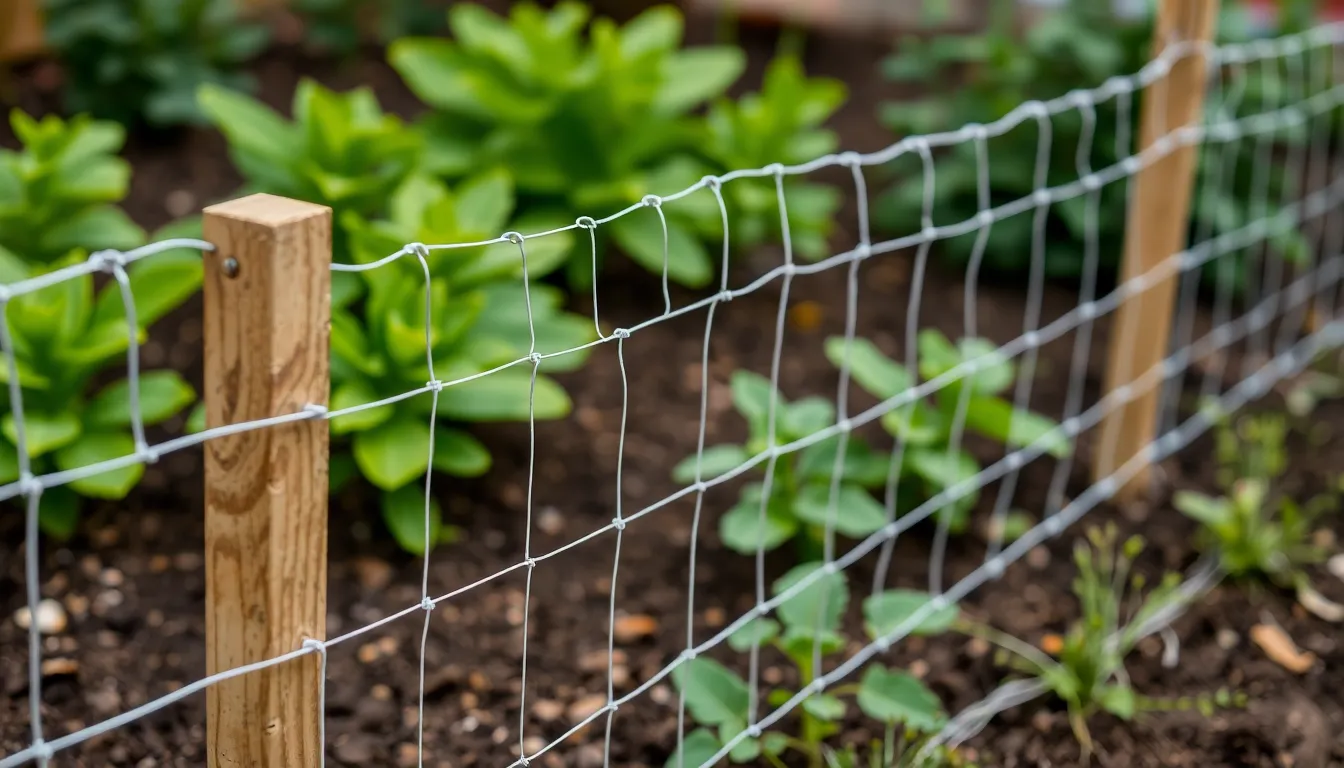
Wire and mesh fencing answers offer excellent value for gardeners who need effective barriers without very costly. These versatile options provide practical protection while keeping installation costs significantly lower than traditional solid fencing.
Chicken Wire Fence with Wooden Posts
Chicken wire fencing delivers the most economical solution for temporary garden barriers and small garden enclosures. We recommend this option for gardeners who need quick installation and maximum cost savings. The lightweight material makes handling simple, and the flexible mesh conforms easily to uneven terrain.
Installation requires basic materials including chicken wire rolls, wooden posts, wire cutters, hammer, and galvanized nails or staples. We typically space wooden posts 6-8 feet apart for optimal support. The mesh attaches directly to posts using a staple gun or heavy-duty staples, creating secure connections that withstand moderate weather conditions.
Cost effectiveness makes this option particularly attractive for budget-conscious homeowners. Chicken wire costs approximately $0.50-1.00 per linear foot, while wooden posts add another $2-4 per post depending on size and wood type. Total material expenses generally range from $3-7 per linear foot for a standard 4-foot height installation.
Hardware Cloth Garden Barriers
Hardware cloth provides superior durability compared to chicken wire while maintaining affordable pricing for most garden projects. We prefer this material for areas requiring protection from small pests like rabbits, squirrels, and rodents. The tighter mesh openings create more effective barriers against determined garden intruders.
Material requirements include hardware cloth rolls, wooden or metal posts, wire cutters, and a heavy-duty staple gun with appropriate fasteners. We recommend using 1/4-inch or 1/2-inch mesh depending on the exact pests you’re targeting. Installation follows similar principles to chicken wire but requires more attention to securing edges properly.
Durability advantages justify the slightly higher cost investment. Hardware cloth typically costs $1.50-3.00 per linear foot, with total project expenses ranging from $5-10 per linear foot including posts and hardware. This option lasts significantly longer than chicken wire, making it cost effective for permanent installations.
Welded Wire Panel Installation
Welded wire panels offer the most structured approach among budget-friendly mesh options, providing excellent stability for larger garden areas. We recommend these panels for gardeners who need professional-looking results without professional installation costs. The rigid construction maintains straight lines and provides consistent height across longer distances.
Panel installation requires welded wire sections, sturdy wooden or metal posts, appropriate fasteners, and basic tools including a drill and level. We typically use 6-foot or 8-foot panel sections to minimize the number of posts needed. Each panel attaches to posts using screws or heavy-duty clips, creating seamless connections between sections.
Investment costs reflect the enhanced structure and appearance these panels provide. Welded wire panels cost approximately $15-25 per 8-foot section, with total material expenses ranging from $8-15 per linear foot including posts and hardware. This represents excellent value for gardeners seeking durability and professional aesthetics on a reasonable budget.
Privacy Fence Ideas for Enclosed Garden Spaces
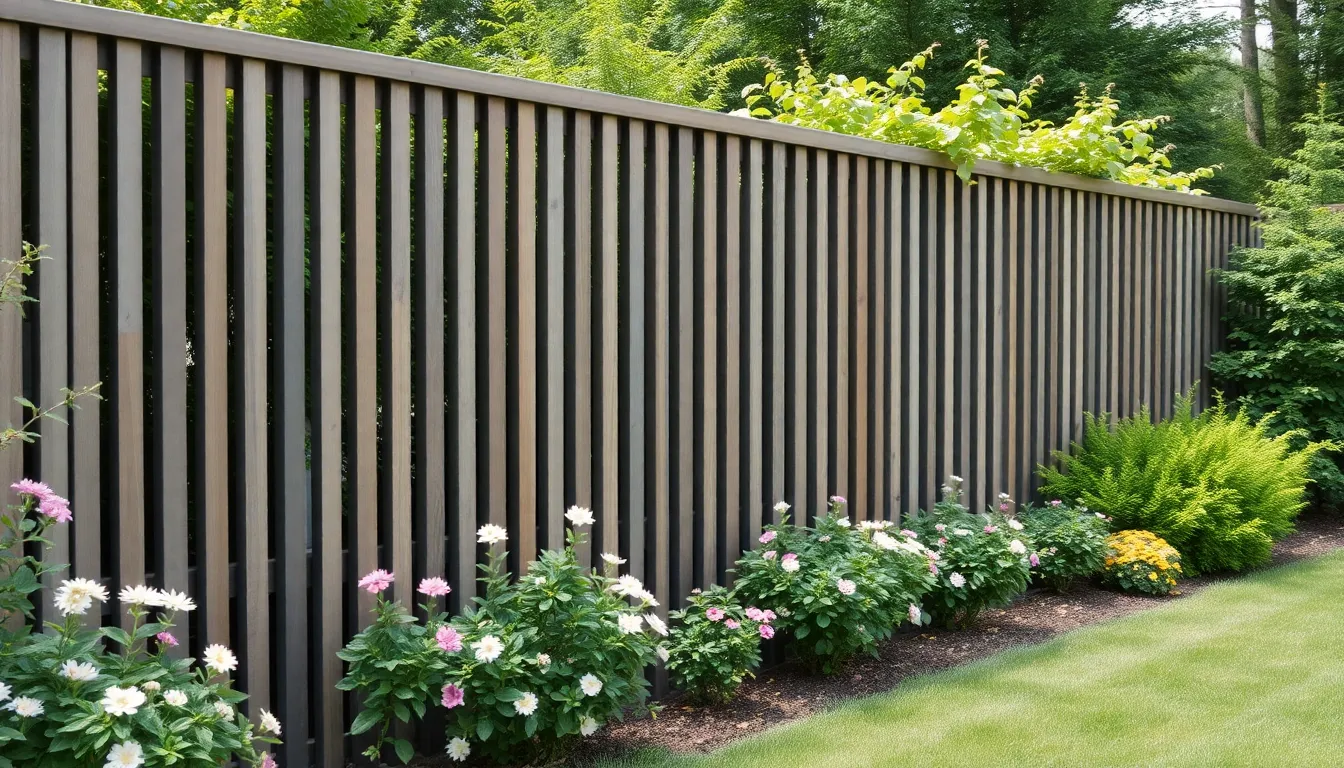
Creating complete privacy in your garden requires strategic fence designs that block sight lines while maintaining visual appeal. We’ll explore three versatile answers that offer both functionality and customization options for your outdoor sanctuary.
Vertical Slat Fence with Spacing Variations
Vertical slat fencing provides our most adaptable privacy solution, allowing you to control visibility levels through strategic spacing adjustments. We can position wood slats closer together for complete privacy or space them wider for filtered views and airflow. This design works exceptionally well when you want to block exact sight lines while maintaining garden ventilation.
Materials needed include pressure treated lumber posts, cedar or pine slats, galvanized screws, and post concrete. Installation involves setting posts 6-8 feet apart, then mounting horizontal support rails between them. We attach vertical slats to these rails, adjusting spacing from zero gaps for maximum privacy to 2-3 inches for partial screening.
Cost ranges from $12-20 per linear foot depending on wood choice and slat width. Maintenance requirements stay minimal with annual staining or sealing to preserve wood integrity. This fence style adapts perfectly to sloped terrain and irregular property lines.
Lattice Top Fence Extensions
Lattice extensions transform existing fences into taller privacy barriers while adding decorative charm to your garden perimeter. We mount pre-fabricated lattice panels above solid fence sections, creating additional height without the visual weight of solid materials. This approach works particularly well when local regulations limit solid fence height but allow decorative extensions.
Pre-fab lattice sheets come in various patterns including diagonal, square grid, and diamond configurations. Installation requires mounting lattice panels between extended fence posts using galvanized brackets and screws. We recommend selecting pressure treated lattice for longevity and weather resistance.
Material costs typically run $8-15 per linear foot for lattice panels and mounting hardware. The installation process takes about 2-3 hours per section and requires basic carpentry skills. These extensions provide climbing support for vines like clematis or morning glories, creating living privacy walls over time.
Fabric and Canvas Screen Combinations
Fabric screens offer our most flexible privacy solution, allowing seasonal adjustments and easy repositioning as garden needs change. We can create temporary or permanent installations using outdoor fabric stretched between posts or wire frames. This method works exceptionally well for renters or gardeners who want non-permanent privacy answers.
Canvas, sailcloth, and specialized outdoor fabrics provide weather resistance while maintaining attractive appearance. Installation involves mounting tensioned wire or cable systems between posts, then attaching fabric with grommets or ties. We can layer multiple fabric panels for varied opacity and visual interest.
Costs range from $5-12 per linear foot for fabric materials and mounting hardware. These screens withstand wind better than solid barriers and create interesting shadow patterns in garden spaces. Maintenance involves periodic cleaning and seasonal removal if desired, making this our most adaptable privacy fence option.
Functional Garden Fence Designs with Built-In Features
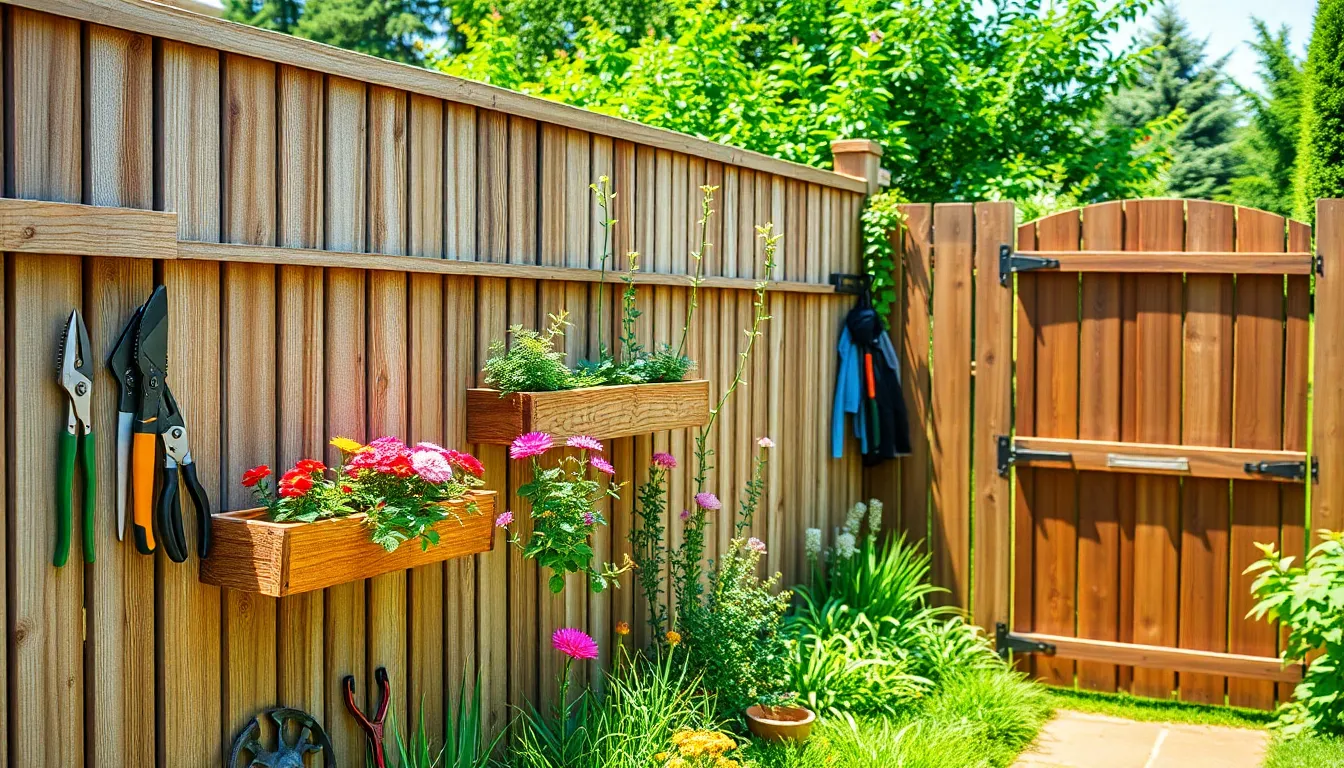
We’ve explored many fence styles, and now it’s time to maximize functionality by incorporating practical features that serve multiple purposes in your garden space.
Fence with Integrated Planter Boxes
Planter box fencing transforms ordinary barriers into productive garden features that maximize growing space along fence lines. We recommend using wooden slats or reclaimed pallets to create fence panels with built-in planting areas that enhance both beauty and functionality.
Construction requires wooden slats, pallets, screws, planters, and quality soil for successful growing. Start by measuring your fence line and determining planter box placement every 4-6 feet for optimal visual balance. Secure wooden slats vertically between fence posts, then attach planter boxes at desired heights using heavy-duty screws.
Benefits include:
- Combines garden space with fencing for dual functionality
- Enhances aesthetic appeal with continuous greenery
- Creates vertical growing opportunities in small spaces
- Provides natural privacy screening as plants mature
Tool Storage Fence Answers
Tool holder fencing keeps essential gardening equipment organized and within easy reach throughout your outdoor workspace. We attach hooks, holders, and storage brackets directly to fence posts to accommodate pruners, gloves, rakes, and other frequently used tools.
Materials needed include wooden fence posts, various hooks, screws, and specialized tool holders designed for outdoor use. Install storage answers at comfortable heights between 3-5 feet for easy access without bending or stretching.
Installation steps:
- Mark tool placement locations on fence posts
- Drill pilot holes to prevent wood splitting
- Secure hooks and holders with weather-resistant screws
- Test weight capacity before hanging heavier tools
This approach keeps tools organized and accessible while freeing up shed space for larger equipment.
Gate and Entry Design Integration
Decorative gate design creates striking entry points that complement your garden’s overall aesthetic while providing functional access. We recommend using materials like wood, metal, or reclaimed materials to create unique entryways that reflect your personal style.
Essential materials include your chosen gate material, heavy-duty hinges, secure locking mechanisms, and weather-resistant hardware. Design considerations should account for gate width, swing direction, and clearance requirements for maintenance equipment.
Design options include:
- Arched wooden gates with climbing plant supports
- Modern metal frames with decorative infill panels
- Repurposed door conversions with original hardware
- Living gates integrated with hedge plantings
Benefits cover enhanced visual appeal at garden entrances and improved functionality for daily access needs. Gates also provide security control points and can incorporate lighting or address displays for additional practicality.
Conclusion
We’ve explored an incredible range of DIY garden fence options that can transform any outdoor space. From budget-friendly wire mesh answers starting at just $3 per linear foot to sophisticated living barriers that grow more beautiful over time these projects prove that style doesn’t have to expensive.
The beauty of DIY fencing lies in the endless possibilities for customization. Whether you’re drawn to rustic reclaimed wood modern steel slats or creative recycled materials you can create a fence that perfectly reflects your personality and meets your garden’s exact needs.
Remember that the best fence combines functionality with aesthetics. We encourage you to mix and match these ideas experiment with different materials and don’t be afraid to add your own creative touches. Your garden deserves a boundary that’s as unique as the space it protects.
Frequently Asked Questions
How much does DIY garden fencing typically cost?
DIY garden fencing costs vary significantly by material type. Budget-friendly wire and mesh options range from $3-15 per linear foot, while rustic wooden fences cost $8-25 per linear foot. Modern metal fencing is pricier at $12-35 per linear foot. Living fences with bamboo or willow cost $5-20 per linear foot. Overall, DIY installation saves considerably on labor costs.
What are the easiest DIY fence options for beginners?
The easiest DIY fence options for beginners include chicken wire fencing, pallet wood fences, and simple split rail designs. These require basic tools and minimal carpentry skills. Wire and mesh fences are particularly beginner-friendly, involving straightforward post installation and wire attachment. Start with smaller sections to build confidence before tackling larger projects.
How long does it take to build a DIY garden fence?
Most DIY garden fence projects can be completed over a weekend with proper planning. Simple wire fencing takes 1-2 days, while wooden fences require 2-3 days depending on length and complexity. Preparation time includes measuring, purchasing materials, and marking post locations. Weather conditions and soil type can affect installation timing.
What tools do I need for DIY fence installation?
Essential tools for DIY fence installation include a post-hole digger or shovel, level, measuring tape, drill or screwdriver, hammer, and wire cutters. For wooden fences, add a saw and sandpaper. A wheelbarrow helps transport materials. Rent specialized tools like power augers for multiple post installations to save time and effort.
Can I build a fence on uneven ground?
Yes, you can build fences on uneven ground using stepped or contoured installation methods. Stepped fencing maintains level fence sections with varying post heights. Contoured fencing follows ground slope naturally. Both approaches require careful planning and measurement. Consider grading severely uneven areas or choosing flexible materials like wire mesh for easier installation.
What materials work best for recycled garden fencing?
Excellent recycled materials for garden fencing include wooden pallets, old doors, window frames, and corrugated metal sheets. Pallets offer versatility and cost-effectiveness when properly treated. Old doors create unique decorative panels. Tires can serve as planter-fence combinations. Always inspect recycled materials for safety and treat wood against rot and pests.
How do I maintain different types of garden fences?
Maintenance varies by material type. Wooden fences need annual staining or sealing to prevent rot. Metal fences require rust inspection and touch-up painting. Wire fences need tension checks and vegetation trimming. Living fences require regular pruning and watering. Clean all fence types seasonally and inspect for damage after storms.
Are there fencing options that provide both privacy and functionality?
Yes, several options combine privacy with functionality. Planter box fencing creates privacy while growing plants. Vertical slat fencing with adjustable spacing controls visibility levels. Lattice top extensions add height and charm to existing fences. Fabric screen combinations offer flexible seasonal privacy. These designs maximize space utility while maintaining aesthetic appeal.

